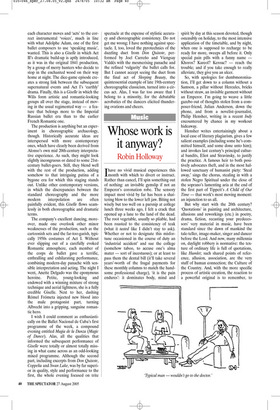Seamless flow
Giannandrea Poesio
Ballet Nacional de Cuba: Giselle; Magia de la Danza
Sadler’s Wells Theatre
Iam always thrilled by a good performance of Giselle, especially when it is informed by choreographic consistency, dramatic fluidity and historical accuracy. That is why, last Friday, I left Sadler’s Wells in a jolly good mood. Indeed, Ballet Nacional de Cuba’s Giselle benefits greatly from the insight of its artistic director Alicia Alonso, a living legend and one of the 20th century’s greatest interpreters of the title role. Alonso’s acute sensitivity to the subtle nuances that underpin the classic does not stem solely from her dancing experience, but also draws clearly on historical research into the choreographic and performing formulae of the Romantic era. Attention to historical detail was clearly evident in many of the distinctive features of the performance I saw: the carriage of the arms, the placement of the corps de ballet on stage in the second act, the restoration of long-deleted scenes and, most of all, the flawless interaction between the choreographic text and the musical one.
In other words, this is a Giselle in which each character moves and ‘acts’ to the correct instrumental ‘voices’, much in line with what Adolphe Adam, one of the first ballet composers to use ‘speaking music’, wanted. This is also a Giselle in which Act II’s dramatic build-up is aptly introduced, as it was in the original 1841 production, by a group of merry hunters who decide to stop in the enchanted wood on their way home at night. The dice-game episode creates a strong link between the subsequent supernatural events and Act I’s ‘earthly’ drama. Finally, this is a Giselle in which the Wilis form artistic and romantic-looking groups all over the stage, instead of moving in the usual regimented way — a feature that belongs more to the Imperial Russian ballet era than to the earlier French Romantic one.
The production is anything but an experiment in choreographic archaeology, though. Historically accurate ideas are interspersed with more contemporary ones, which have clearly been derived from Alonso’s own mid 20th-century interpretative experience. As such, they might look slightly incongruous or dated to some 21stcentury ballet-goers. Still, they blend well with the rest of the production, adding somehow to that intriguing patina of a bygone era for which this staging stands out. Unlike other contemporary versions, in which the discrepancies between the standard choreography and the more modern interpolation are often painfully evident, this Giselle flows seamlessly in both choreographic and dramatic terms.
The company’s excellent dancing, moreover, made one overlook other minor weaknesses of the production, such as the cartoonish sets and the far-too-garish, typically 1950s costumes of Act I. Without ever slipping out of a carefully evoked Romantic atmosphere, each member of the corps de ballet gave a terrific, enthralling and exhilarating performance, combining modern-day panache with sensible interpretation and acting. The night I went, Anette Delgado was the eponymous heroine. Petite, young-looking and endowed with a winning mixture of strong technique and aerial lightness, she is a fully credible Giselle. Next to her, dashing Rómel Frómeta injected new blood into the male protagonist part, turning Albrecht into a gripping, sanguine romantic hero.
I wish I could comment as enthusiastically on the Ballet Nacional de Cuba’s first programme of the week, a compound evening entitled Magia de la Danza (Magic of Dance). Alas, all the qualities that informed the subsequent performance of Giselle were totally or almost totally missing in what came across as an odd-looking mixed programme. Although the second part, including excerpts from Don Quixote, Coppelia and Swan Lake, was by far superior in quality, style and performance to the first, the whole evening focused on trite spectacle at the expense of stylistic accuracy and choreographic consistency. Do not get me wrong; I have nothing against spectacle. I, too, loved the pyrotechnics of the dazzling duet from Don Quixote, performed by Joel Carreflo and Viengsay Valdés with the mesmerising panache and the refined ‘vulgarity’ the ballet calls for. But I cannot accept seeing the duet from the final act of Sleeping Beauty, the quintessential example of late 19th-century choreographic classicism, turned into a circus act. Alas, I was far too aware that I belong to a minority, for the debatable acrobatics of the dancers elicited thundering ovations and cheers.












































 Previous page
Previous page